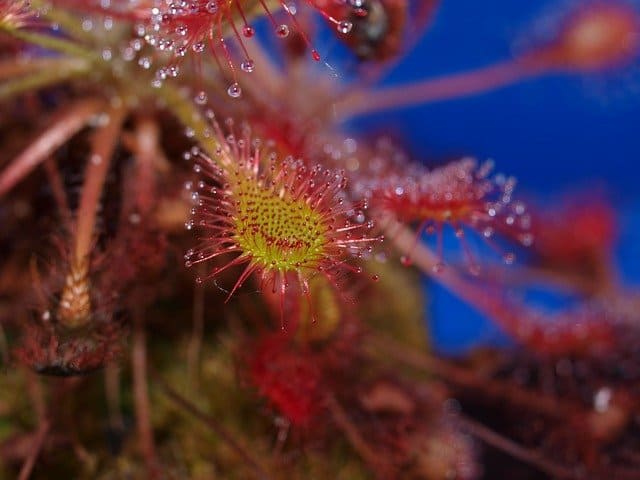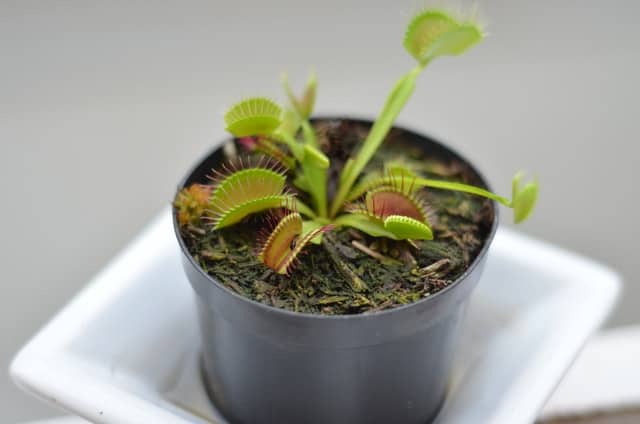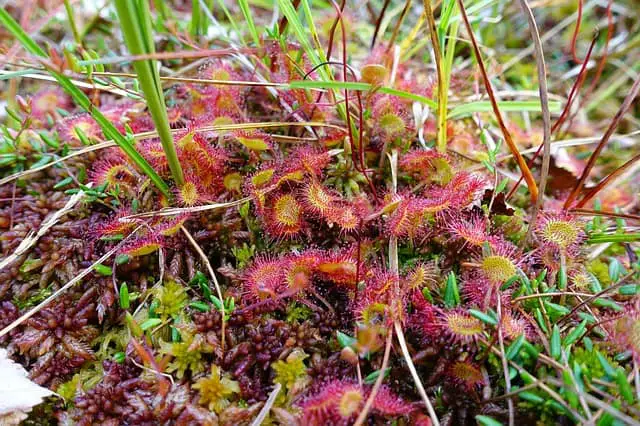Carnivorous plants require specific care instructions. This article covers all you need to know to grow Drosera Spatulata also known as Spoonleaf Sundew.
| Care Consideration | Recommendation |
|---|---|
| Lighting Requirement: | 13-16 hours of light exposure through natural or artificial light. |
| Water: | Keep the soil moist at all times, but do not create swamp-like conditions. The water tray method is optimal. |
| Temperature: | 45 – 90 F (7-32 C) |
| Trimming: | Occasionally trim dead leaves. |
| Feeding: | Place the plant where there is access to live feed or feed it manually. Flies, bloodworms, mealworms, and gnats are excellent food options. |
| Fertilizers: | Not required. |
| Propagation: | Seeds, leaf pullings, root cuttings. |
| Pots: | Employ plastic, glazed ceramic or glass pots with drainage. |
| Repotting: | No need to repot frequently. |
| Dormancy: | No required. |
| Outdoor vs Indoor growth: | Indoor growing is preferred to secure the lighting and temperature requirements. |
This list is a quick summary of the Drosera Spatulata care instructions. You can download this information in a PDF format by following this link. The section below includes a detailed overview of all the items in the summary. Keep reading to get the whole picture.
Follow this link for a complete overview on carnivorous plant care. The article contains tons of information on several types of carnivorous plants.
Drosera Spatulata Care Guide
Drosera spatulata is a carnivorous plant that widely grows in areas that have moderate or cold temperatures such as Australia, China, Japan, New Guinea, New Zealand, Micronesia, and Tasmania. This plant’s most distinguishing characteristics are its rosette-like structure and multicolored leaves and flowers.

Some people refer to Drosera spatulata as Spoonleaf sundew. This is due to its spoon-shaped leaves or tentacles as others like to call them. Because of its striking color and shape, many are growing this Spoonleaf sundew as an indoor plant for houses, offices, pubs, and other establishments.
Botanists recommend that beginners should opt to grow Drosera spatulata if they wish to learn how to grow sundews. Growing this plant is very easy.
In this article, I’ll be giving you all the essential knowledge for growing Drosera spatulata successfully.
Soil and Pot Requirements
The spoon leaf sundew is a very curious plant. It doesn’t grow well in nutrient-rich soil but prefer’s a barren one instead. 50% silica sand and 50% sphagnum moss is suitable potting media. You can also try employing only sphagnum moss if silica sand isn’t available. Another option is employing peat moss and perlite.
You can buy carnivorous plant soil online, like this one I use. It usually costs less than 10 dollars for a quart. Follow the link to confirm the price on Amazon.
Spoonleaf sundew can grow in any pot as long as it’s not cramped. However, try using moderately sized pots for the best results. I recommend that you use a pot with an opening that measures 9 centimeters, a height of 8 centimeters, and a base of 6 centimeters.
Aside from pots, you can also opt to grow the Spoonleaf sundew using trays. Some botanists love to use trays instead of pots because they’re more spacious. Thus, they don’t risk the Spoonleaf sundew to restricted growth. All trays will do so long as they’re durable. If you’re planning to raise 5 or more Spoonleaf sundews at once, I suggest that you grow them on a tray instead of a pot.
These pots are some good examples of suitable containers for Venus flytraps. Follow the links below to check their specs and their current price on Amazon.
- Nursery pots for single plants: https://amzn.to/34Q6byu
- Net pots for single plants: https://amzn.to/2TMqgDJ
Watering Process
The nutrition of the Spoonleaf sundew mostly come from insects. However, the water that’s crucial for its growth comes from the soil where it growing. This is one of the reasons why the soil for Spoonleaf sundew needs to be a bit sandy. Sandy soil absorbs water well. However, it doesn’t retain it for too long. Thus, it supplies the Spoonleaf sundew with enough water without making things too moist.
What kind of water is best for the Spoonleaf sundew?
Spoonleaf sundews require pure water, such as rainwater, distilled water, and reverse osmosis water. Acidic water isn’t good for this plant because it might affect the growth, color, and durability of leaves and tentacles.
The Spoonleaf sundew doesn’t like watering that’s done haphazardly and forcefully. In the wild, this plant gets water gradually and slowly. Usually, it gets water through light rains and water vapor which moisturize the soil where it grows. The Spoonleaf sundew will be very happy if you can emulate this.
A slow sprinkler best emulates the natural watering process that Spoonleaf sundew experiences in the wild. Small slow sprinklers are available in the market. You can opt to use the manual version or have the automatic one installed. Assuming that you’re Spoonleaf sundew as a hobby, I suggest that you go for the manual version.
You can also opt to use the tray method for watering various Spoonleaf sundews at the same time. The tray method is perhaps the best for watering not only Spoonleaf sundews but other carnivorous plants. This is because it provides moisture gradually and non-excessively. However, note that you can only use the tray method for watering Spoonleaf sundews that are growing on pots.
You only have to do three things to water Spoonleaf sundews with the tray method:
- Get a large and deep tray and ensure that it doesn’t have holes or cracks that might cause leaking
- Fill it with water but remember not to put too much ( the amount should be just enough for the pots’ most bottom portion to get submerged)
- Place the pots which contain the Spoonleaf sundews

Though quite good, one thing that I don’t like about the tray method is that it promotes mosquitoes to frequent in the house. It’s because mosquitoes will come to lay their eggs on the water that’s in the tray. This is an issue when the Spoonleaf sundews are still growing. However, this problem becomes minor after the Spoonleaf sundews reach maturity. Then, mosquitoes get trapped in the plant’s tentacles.
How often to water the Spoon leaf sundews depends on the watering method that you decide to follow. If you use the tray method, it’s best to leave the pots that contain the Spoonleaf sundews soaked for at least a day. After that, there’s no need to water for at least a week. For slow sprinklers, you have to water the Spoon leaf sundews at least twice per week (here is a guide on sundew watering). (here is a guide on sundew watering)..
Temperature and Humidity
Drosera spatulata isn’t very picky about temperature. However, you have to try growing it in a setting that emulates the subtropical conditions of its natural habitat. Specifically, this plant grows at temperatures ranging from 45 – 90 F (7-32 C).
Humidity, on the other hand, isn’t an issue. This plant won’t have problems growing even when the environment is moist or wet. Just remember to maintain its soil in pristine condition and keep it watered.
Also, the Drosera spatulata that comes from New Zealand grows better in a cold setting. Therefore, consider giving this lesser lighting and photoperiod. New Zealand’s Drosera spatulata is a bit sensitive to humidity. So you should buy a cheap humidifier for growing it. The recommended humidity for it is 60%
Lighting and Photoperiod
The Spoonleaf sundew grows well under sunlight. However, consider using fluorescent lights if you’re living in an area where the quality of sunlight is poor. Some even prefer using fluorescent light even when sunlight is already adequate. This is because fluorescent light provides more control and allows you to decide how much photoperiod the Spoonleaf sundew gets.
So what’s the best type of florescent lighting for Spoonleaf sundew? If you’re willing to invest, T-8 lights will do. You can also opt to use T5 lights. However, I think that T-8 lights are the best option because they’re not very warm or bright. For choosing between various kinds of T-8 lights. Go for ones that have a minimum capacity of 50-watts or lower
Spoonleaf sundew requires a minimum of 13 hours or a 16-hour photoperiod to grow well. The photoperiod refers to the duration of a plant’s exposure to light. Adequate photoperiod is important because the Spoonleaf sundew needs a lot of active time trapping insects to get nutrition.
Fertilizers
Does Drosera Spatulata need fertilizers? The big answer is no.
Fertilizers are useless for Drosera Spatulata. The soil plays a very little role in its nutrition. This plant gets most of its nutrients from the insects that get trapped in its tentacles. In fact, putting fertilizers might harm than good. It might make the soil too acidic or too alkaline and thus cause Drosera Spatulata to die.
Instead of using fertilizers, you should ensure that the soil where the Drosera spatulata is growing stays sandy or coarse. Also, avoid making the soil too moist. This plant doesn’t like muddy soil and fine soil. You can avoid this by adjusting the soil composition from time to time.
Feeding Requirement
In most cases, insects get themselves trapped on the leaves of the Spoonleaf sundew. Therefore, there’s no need to catch insects and put them on the leaves yourself. However, it’s another story if you’re growing the Spoonleaf sundew on a location where insects don’t visit often.
You can feed your Sundew manually. Some great food options are mealworms, fruit flies, flies, bloodworms, ants, and gnats.
It takes days for the Spoonleaf sundew to require feeding again. Enzymes that it releases often digest the insect slowly. As a result, the absorption of nutrients doesn’t happen in a flash. You’ll know that the Spoonleaf sundew requires feeding again as soon as one or more of its tentacles are widely opened.
Does Drosera Spatulata Undergo Dormancy?
Drosera Spatulata that comes from China, Japan, Australia, New Guinea, and Tasmania, doesn’t undergo dormancy. They don’t grow differently through the winter. Due to their lack of dormancy, this species is considered an excellent plant for first-time carnivorous plant owners.
Pruning
The Spoonleaf sundew is a small plant. After growing fully, it might only reach a maximum width of 1 or 3 inches. As it grows, some of its leaves will wither. You can safely prune the dead leaves. However, you must avoid trimming any healthy leaves. This plant greatly relies on its spoon-shaped tentacles to capture insects. Trimming healthy leaves can kill the plant.
Repotting
Repotting a Sundew isn’t hard. If you decide to transfer a Spoonleaf sundew from a tray to a pot, remember not to put it out of the soil. Instead, you should transfer this plant to the pot with the soil where it’s planted. Repotting doesn’t inflict abnormalities on the growth of Spoonleaf sundew. It will grow as usual after it’s transferred.
Propagation
The Drosera spatulata propagates through different methods, such as seeds, leaf cuttings, and divisions.
Existing Drosera spatula produces seeds through self-pollination. The seeds come from the flowers that it produces. The amount of seeds is relative to the number of flowers. If nutrition is good, Drosera Spatulata produces 10 or 20 flowers that provide several seeds that take 3 weeks to germinate.
If you decide to grow this plant from a seed, avoid burying it deeply. Also, ensure that the soil isn’t too cold or moist for germination to occur.
Do’s and Don’t For Growing Spoonleaf Sundews
Do
- Plant the Spoonleaf sundew in a pot that contains a soil which is a mix of sand and sphagnum moss
- Water this plant slowly
- Provide this plant with a lengthy photoperiod
- Use fluorescent lighting for growing this Spoonleaf sundew indoors
- Feed your plant regularly if it does not have access to feed
Don’t
- Grow Spoonleaf sundew in a location where insects don’t frequent
- Use acidic water for watering this plant
- Employ soil with fertilizers
- Use strong insecticides and fertilizers while growing this plant
Growing Drosera Spatulata Indoors
Drosera Spatulata can be grown outdoors or indoors. However, indoors provide a more controllable environment. Therefore, growing this plant inside is the best option that ensures success. What you need for growing Drosera spatulata indoors are adequate lighting, pots, trays, and a slow sprinkler.
The things that I’ve discussed earlier apply best for growing this plant inside the house or any other building. Aside from control, other reasons that you’ll enjoy when growing this plant indoors are better growth, protection against disease, less sensitivity to environmental conditions, etc.
Drosera spatulata looks very beautiful. Nevertheless, appearance is only one benefit that this plant brings. Drosera spatulata can help with the prevention of insect infestation if you manage to grow lots. That said, this might be what you need for making the indoors look good and insect free.
Besides the Drosera Spatulata, there are many other fascinating carnivorous plants you can own. This article contains a list of 10 carnivorous plants, it gives you a plant overview for each and shows you pictures.


